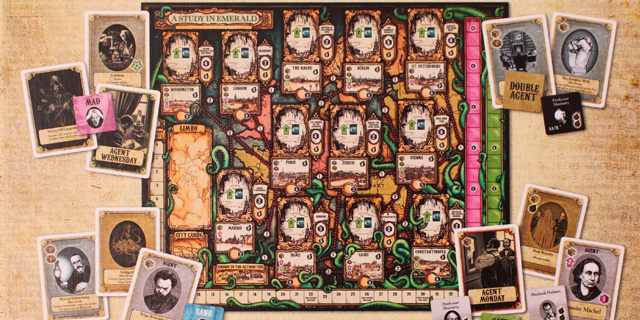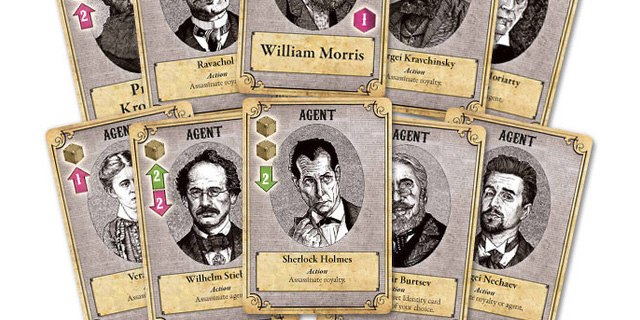
When I first heard that Martin Wallace (The Witches, Ankh-Morpork and other non-Discworld games I haven’t covered) was designing a board game based on Neil Gaiman’s Sherlock Holmes-Lovecraft mash-up short story A Study In Emerald, my response was literally “take my money!” I haven’t even read the story yet, but the concept and talent involved sold me. So how did the actual game version of A Study in Emerald turn out? It’s mixed, honestly, but on the whole a satisfying experience.
Much like its inspiration, Emerald pulls several disparate mechanics and blends them together into something resembling a cohesive unit. Deck-building, area control, token movement and Lovecraftian-mandated insanity all feature prominently, but perhaps the most important aspect of Emerald is the hidden role each player receives at the start of the game. Players are secretly divided into two camps: Loyalists or Restorationists. Loyalists are trying to maintain the status quo of ancient elder gods masquerading as nobility, while Restorationists are fighting to return humanity to control.
The role you receive will inform your strategy by determining how you score some of your points. Both factions receive points for controlling cities or being in possession of the Necronomicon. Restorationists receive points for controlling specific agents, assassinating royalty and progressing the Revolution track. Loyalists receive points for assassinating agents controlled by Restorationists, safely hiding royalty and advancing the War track. Some specific cards might also grant one faction points, should they appear and be acquired by the right player.

Each city on the board is dealt a stack of cards, but not all of the cards included in the game will be available for a given session. Combined with the cards representing the cities themselves and the base deck each player begins with, these represent various agents and other entities over which the players can exert their influence. Most cards have symbols on them that power the actions players can take. Cube symbols let a player place or retrieve influence cubes, coins can be used to either buy new cubes or move agents, arrows move their respective track up or down and bombs assist in assassination attempts. Some cards have their own actions (mostly assassinating), others are “free actions” and a few are one-use only and are removed from the game once played.
To acquire a new card, a player must first have the most influence over it. Cubes placed on that card or city plus any agents present in the corresponding city all add up to total influence. In the event of a tie, the player with the most agents wins although at least one of your cubes must be present for you to claim the card. The catch: acquiring a new card can only be done with the first of your two actions each turn, meaning that you cannot ambush your opponents with an unexpected acquisition. Every other player will have a chance to block you from being able to claim that card between the time you place influence on it and the time you can attempt to actually claim it. And that’s only the start of the political maneuvering that will go on as a game of Emerald unfolds.
At the beginning of the game, each player is randomly dealt a number of Double Agent tokens. As an action, a player may reveal one of those tokens to wrest control of the named agent from another player. These Double Agent tokens can also be used to counter an opponent’s assassination attempt in a similar manner, although Sherlock Holmes and Professor Moriarty are somewhat resistant to this depending on the allegiance of their current controller.

Retaining Holmes or Moriarty is one of the few ways your faction can be revealed before the end of the game. Should you ever accumulate three “mad” sanity results, you will be forced to reveal; Loyalists are fine (there’s more willing drones where you came from), but a Restorationist who goes mad will end the game. The game can also end if a Restorationist’s Main Agent is assassinated, although there are a number of checks in place to ensure that this does not happen prematurely. Finally, you may reveal your allegiance as an action, but only if doing so would award you enough points to push you over the threshold for ending the game.
Once the game has ended and the scores are adjusted, there is one final twist that makes Emerald truly treacherous. Before a winner is determined, the entire faction of the player in last place is eliminated (Loyalists lose ties). Of the faction left standing, whoever has the most points is the winner.
There are only three loyalty cards of each faction. In a five-player game, the teams will always be three vs. two, four players could be two vs. two or three vs. one, while a three-player session is either two-on-one or every man for himself. In the case of a “many vs. one” scenario, all the lone player has to do to win is not finish last.
This team elimination mechanic drives the entire second half of the game. Once the initial feeling out process is complete, players can usually form a decent hypothesis about the two “teams”. The trick then becomes to position yourself as the highest-scoring member of your faction while simultaneously ensuring that at least one of your rivals finishes last. This is a devious tug-of-war, and its very easy for an outnumbered faction to slip through the cracks of a larger faction’s internal power struggle.

As fascinating as the dynamic created by this two-pronged jockeying for position is, Emerald is certainly not without its faults. The overall graphic design of the game leaves a lot to be desired, from the too-busy board to the too-plain Agent and (especially) Double Agent tokens. Speaking of Agents, the specific mix of them that is randomly available each game can have a dramatic impact on how the game plays out. If few Agents capable of assassinating royalty show up, that cuts off the Restorationists from a potentially-significant source of points and turns the game into a brawl over control of the cities.
The biggest problem with the game, though, is its inherent complexity. There are a lot of cards with unique abilities, and there is not nearly enough room on the cards themselves. This results in a lot of referencing both the included player aids and the rules themselves. It also makes teaching the game a chore, although the actual mechanics are mostly simple enough once you start playing.
I like a lot of what is going on in A Study in Emerald, and the shortcomings can be overcome with time. On the subject of time, a session of Emerald should run about two hours, depending on number of players and how vicious the inevitable endgame tug-of-war gets.
A Study in Emerald retails for $80 via Cool Stuff Inc. or 55€/£48 directly from Treefrog Games. That’s a lot, I know, so try and play someone else’s copy first if possible.



















